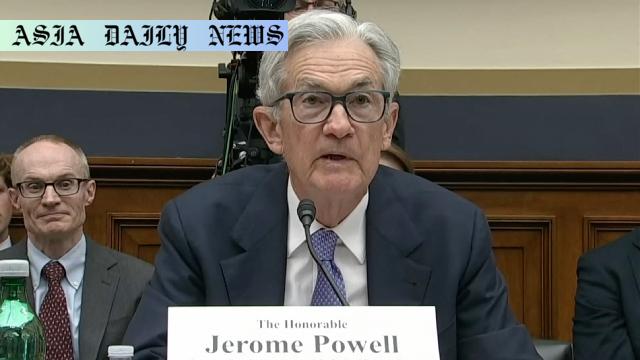Interest Rates: US Federal Reserve Chair Jerome Powell emphasizes a cautious approach on cutting rates, citing economic conditions.
US Federal Reserve Chair Jerome Powell takes a cautious stance on cutting interest rates.
Powell highlights the potential short-term and long-term effects of tariffs on inflation.
Trump continues to pressure the Federal Reserve for interest rate cuts.
Two senior Fed officials signal support for rate cuts if conditions are met.
Upcoming price and employment data will play a critical role in shaping monetary policy.

Powell’s Position on Interest Rates
US Federal Reserve Chair Jerome Powell underscored a cautious outlook on adjusting interest rates during his recent address to a House committee. Powell stressed the importance of maintaining a steady policy trajectory to ensure economic stability amid prevailing uncertainties. His remarks come at a critical time as international tariffs introduced by President Donald Trump’s administration introduce new dynamics into the economy.
Powell clarified that while tariffs might have short-term inflationary effects, their long-term implications remain uncertain. He stated, “Increases in tariffs this year are likely to push up prices and weigh on economic activity.” Furthermore, he highlighted the critical need to carefully assess potential outcomes, indicating that the broader economy, bolstered by a strong labor market, currently does not necessitate drastic policy shifts.
Impact of Tariffs on Inflation and the Economy
The broader economic implications of tariff adjustments, especially their impact on inflation, have emerged as a significant area of concern. Powell noted that while inflationary effects might be “short-lived,” there is a possibility of these effects being more persistent than anticipated. The Federal Reserve, therefore, believes in adopting a measured approach, waiting to observe more concrete trends in economic activity and employment data before making any aggressive cuts to interest rates.
Such an approach reflects a balance between reacting to market forces and maintaining fiscal stability. While some economic indicators suggest resilience, the unpredictable nature of tariffs and their potential ripple effects highlight the need for caution in monetary policymaking.
Contrasting Views within the Federal Reserve
Despite Powell’s steadfast stance, opinions within the Federal Reserve are not entirely uniform. Vice Chair for Supervision Michelle Bowman and board member Christopher Waller have publicly expressed openness to rate cuts, perhaps as early as the July policy board meeting, provided specific conditions are met. Their statements indicate a willingness within segments of the Fed to respond dynamically to emerging economic conditions.
This divergence reflects the inherent challenges of designing monetary policies in a complex economic landscape characterized by competing demands and rapidly shifting variables. For Powell and his supporters, exercising caution is vital to ensuring that interest rate adjustments do not unintentionally destabilize the economy.
Trump’s Advocacy for Rate Reductions
President Trump’s vocal advocacy for lower interest rates has added further complexity to the Federal Reserve’s decision-making process. Since the beginning of his second term, Trump has consistently urged the Fed to cut rates, aiming to stimulate growth and potentially enhance the economic outlook ahead of upcoming elections.
However, Powell has reiterated the Fed’s independence, reinforcing its role as a non-partisan body committed to prioritizing economic stability over political pressures. His nuanced comments illustrate the challenges of navigating between economic prudence and external advocacy from influential stakeholders.
The Role of Upcoming Data in Decision-Making
As Powell emphasized in his testimony, upcoming data on prices and employment will serve as key indicators for shaping monetary policy. These metrics are expected to provide nuanced insights into the state of the economy, helping the Federal Reserve refine its approach to interest rates in the coming months.
Ultimately, Powell’s remarks signal the importance of basing critical policy decisions on evidence rather than speculation. By adopting a steady and fact-based approach, the Fed seeks to ensure that its actions align with the broader interests of the economy.
Commentary
Understanding the Federal Reserve’s Deliberate Approach
Jerome Powell’s measured approach to interest rate adjustments reflects the Federal Reserve’s commitment to maintaining economic stability amid uncertain conditions. In the face of rising political pressures and complex economic dynamics, Powell’s emphasis on evidence-based decision-making highlights the importance of prioritizing long-term stability over short-term gains. This responsible stance underscores the critical role of central banks in addressing economic challenges without succumbing to external influences.
Repercussions of Tariff Adjustments
The tariffs introduced by the Trump administration serve as a stark reminder of how policy shifts can significantly impact economic landscapes. While Powell’s assertion that these adjustments may lead to temporary inflation underscores the importance of vigilance, his acknowledgment of potential long-term effects signals the need for continuous observation and analysis. Striking a balance between responding to immediate market needs and safeguarding long-term economic interests will remain a crucial endeavor for the Federal Reserve moving forward.
The Importance of Central Bank Independence
The ongoing dialogue between the Federal Reserve and the executive branch, particularly President Trump’s persistent calls for rate reductions, brings the issue of central bank independence into sharp focus. Powell’s remarks reinforce the idea that effective monetary policy is rooted in objective analysis rather than political priorities. Maintaining this independence is essential to ensuring that actions taken by the Federal Reserve serve the broader interests of society rather than catering to specific agendas.
Overall, Powell’s strategy of caution, deliberation, and transparency reflects a well-grounded approach to navigating the challenges facing the US economy. His ability to maintain a steady course amid diverse pressures highlights the significance of prudent leadership in the realm of monetary policy.


